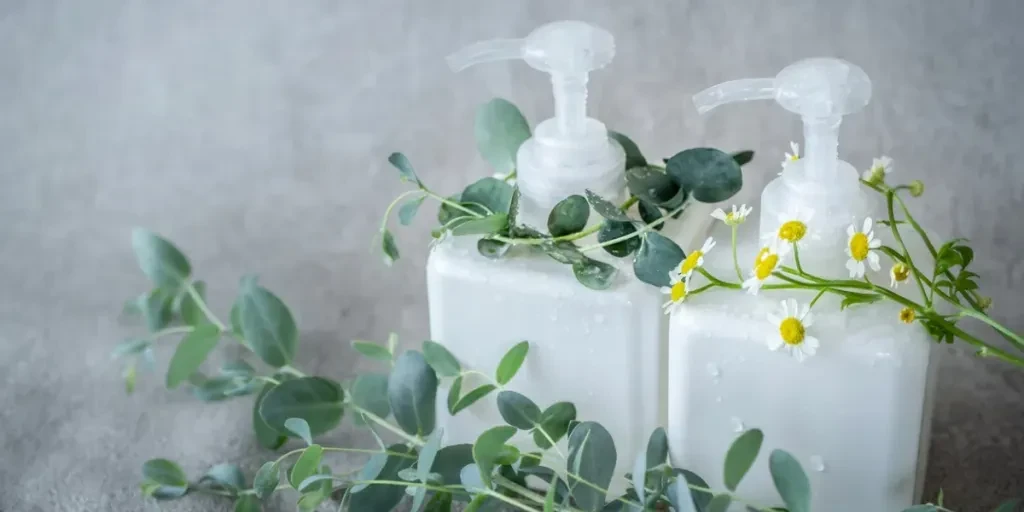В постоянно развивающемся ландшафте красоты и личной гигиены шампуни без химикатов стали значимой тенденцией, привлекая внимание как потребителей, так и корпоративных покупателей. Поскольку спрос на натуральные и органические продукты продолжает расти, понимание нюансов этого рынка становится решающим для розничных и оптовых торговцев, стремящихся удовлетворить предпочтения потребителей и извлечь выгоду из возможностей роста.
Содержание:
– Понимание тенденции: почему шампуни без химикатов набирают популярность
– Изучение популярных типов шампуней без химикатов
– Решение проблем потребителей с помощью шампуней без химикатов
– Инновации и новые продукты на рынке шампуней без химикатов
– Заключительные мысли о поиске шампуней без химикатов для корпоративных покупателей
Понимание тенденции: почему шампуни без химикатов набирают популярность

Что определяет шампунь без химикатов?
Шампуни без химикатов производятся без синтетических химикатов, таких как сульфаты, парабены и силиконы, которые обычно встречаются в обычных средствах по уходу за волосами. В этих шампунях часто используются натуральные и органические ингредиенты, включая растительные масла, ботанические экстракты и эфирные масла, для очищения и питания волос. Отсутствие едких химикатов делает эти продукты более щадящими для кожи головы и волос, снижая риск раздражения и повреждения. Этот сдвиг в сторону более чистых формул соответствует более широкому движению потребителей в сторону выбора, заботящегося о своем здоровье и окружающей среде.
Шумиха в социальных сетях: популярные хэштеги и поддержка влиятельных лиц
Рост популярности шампуней без химикатов можно в значительной степени объяснить силой социальных сетей. Такие платформы, как Instagram и TikTok, стали горячими точками для бьюти-энтузиастов и инфлюенсеров, которые выступают за натуральные процедуры ухода за волосами. Такие хэштеги, как #ChemicalFreeShampoo, #CleanBeauty и #OrganicHairCare, собрали миллионы просмотров, повышая осведомленность и интерес к этим продуктам. Инфлюенсеры и знаменитости, одобряющие шампуни без химикатов, еще больше усиливают их привлекательность, создавая волновой эффект, который влияет на решения потребителей о покупке. Этот шум в социальных сетях не только подчеркивает преимущества шампуней без химикатов, но и способствует формированию сообщества единомышленников, которые отдают приоритет чистой красоте.
Потенциал рынка: растущий спрос и потребительские предпочтения
Потенциал рынка для шампуней без химикатов высок, что обусловлено растущей потребительской базой, которая ценит натуральные и органические продукты. Согласно профессиональному отчету, мировой рынок шампуней без сульфатов, подвида шампуней без химикатов, был оценен в 4.92 млрд долларов США в 2022 году и, по прогнозам, будет расти со среднегодовым темпом роста 3.55% до 2028 года. Этот рост обусловлен повышением осведомленности потребителей о вредном воздействии синтетических химикатов и готовностью инвестировать в высококачественные средства по уходу за волосами премиум-класса.
Более того, прогнозируется, что рынок органических шампуней вырастет на 1.47 млрд долларов США в период 2023-2028 гг., ускорившись на CAGR 11.28%. Это указывает на сильное предпочтение потребителями продуктов, которые не только не содержат вредных химикатов, но и получены из устойчивых источников и являются экологически чистыми. Рост электронной коммерции и каналов прямых продаж потребителям еще больше повысил доступность и разнообразие шампуней без химикатов, удовлетворяя меняющиеся потребности потребителей, заботящихся о своем здоровье.
В заключение следует сказать, что тенденция к использованию шампуней без химикатов — это не просто мимолетная мода; она представляет собой существенный сдвиг в поведении и предпочтениях потребителей. Для корпоративных покупателей в индустрии красоты и личной гигиены понимание этой тенденции и ее рыночного потенциала имеет важное значение для принятия обоснованных решений о закупках и сохранения лидирующих позиций на конкурентном рынке.
Изучение популярных типов шампуней без химикатов

Органические и натуральные ингредиенты: преимущества и недостатки
Органические и натуральные ингредиенты в шампунях без химикатов приобрели значительную популярность в последние годы. Эти шампуни часто содержат растительные компоненты, такие как алоэ вера, кокосовое масло и эфирные масла, которые известны своими питательными свойствами. Согласно отчету Euromonitor International, спрос на натуральные и органические средства по уходу за волосами растет, что обусловлено растущей осведомленностью потребителей о потенциальных рисках для здоровья, связанных с синтетическими химикатами.
Преимущества использования органических и натуральных ингредиентов многочисленны. Они, как правило, мягче воздействуют на кожу головы и волосы, снижая риск раздражения и аллергических реакций. Например, такие продукты, как линия по уходу за волосами Aveda Be Curly Advanced, используют веганские пептиды для укрепления локонов, полученные из гидролизованного горохового белка, которые улучшают здоровье волос без использования агрессивных химикатов. Кроме того, эти ингредиенты часто получают из экологически чистых источников, что соответствует растущему предпочтению потребителей к экологически чистым продуктам.
Однако есть и недостатки, которые следует учитывать. Натуральные ингредиенты иногда могут быть менее эффективными с точки зрения очищающей способности по сравнению с их синтетическими аналогами. Более того, срок годности органических продуктов может быть короче из-за отсутствия консервантов. Бизнес-покупатели должны тщательно взвешивать эти факторы, гарантируя, что закупаемые ими продукты соответствуют как ожиданиям потребителей, так и практическим требованиям.
Шампуни без сульфатов: эффективность и отзывы потребителей
Шампуни без сульфатов стали основным продуктом на рынке шампуней без химикатов. Сульфаты, такие как лаурилсульфат натрия (SLS) и лауретсульфат натрия (SLES), обычно используются в шампунях из-за их пенообразующих и очищающих свойств. Однако они могут лишать волосы их натуральных масел, что приводит к сухости и раздражению. В результате были разработаны альтернативы без сульфатов, обеспечивающие более щадящее очищение.
Отзывы потребителей о шампунях без сульфатов в основном положительные. Такие продукты, как шампунь Verb's Dandruff Shampoo, в состав которого входит 3% салициловой кислоты, получили высокую оценку за способность уменьшать перхоть и поддерживать здоровье кожи головы без резкого воздействия сульфатов. Кроме того, шампуни без сульфатов часто рекомендуются людям с окрашенными или химически обработанными волосами, поскольку они помогают сохранить цвет и предотвратить дальнейшее повреждение.
Эффективность, однако, может варьироваться в зависимости от формулы. Некоторые потребители могут обнаружить, что шампуни без сульфатов не так хорошо пенятся или оставляют волосы менее чистыми. Покупателям-предпринимателям следует рассмотреть возможность предложения ряда вариантов без сульфатов для удовлетворения различных типов волос и предпочтений, гарантируя, что их линейка продуктов соответствует разнообразным потребностям потребителей.
Варианты без парабенов: польза для здоровья и восприятие рынком
Парабены — это синтетические консерванты, которые обычно используются в средствах личной гигиены для продления срока годности. Однако опасения по поводу их потенциальных рисков для здоровья, включая гормональные нарушения и связь с раком, привели к росту спроса на альтернативы без парабенов. Рынок воспринял шампуни без парабенов в подавляющем большинстве положительно, и потребители все чаще ищут продукты, которые ставят безопасность и здоровье на первое место.
Такие бренды, как Schwarzkopf Professional, отреагировали на этот спрос, выпустив линии красок для волос без парабенов, например, Igora Zero Amm, которая также не содержит аммиак и отдушки. Эти продукты не только удовлетворяют потребности потребителей, заботящихся о своем здоровье, но и предлагают улучшенное направление цвета и покрытие, что повышает их привлекательность.
Польза для здоровья от шампуней без парабенов значительна. Они снижают риск раздражения кожи и аллергических реакций, что делает их подходящими для людей с чувствительной кожей. Кроме того, отсутствие парабенов соответствует более широкой тенденции к чистой и зеленой красоте, которая подчеркивает использование безопасных, нетоксичных ингредиентов. Бизнес-покупатели должны учитывать растущее предпочтение потребителей продукции без парабенов при отборе своего инвентаря, гарантируя, что они предлагают варианты, которые соответствуют этим стандартам здоровья и безопасности.
Решение проблем потребителей с помощью шампуней без химикатов

Распространенные проблемы с волосами и кожей головы: как помогают шампуни без химикатов
Шампуни без химикатов предназначены для решения различных распространенных проблем с волосами и кожей головы, предлагая решения, которые являются как эффективными, так и мягкими. Например, такие продукты, как NatureLab. Шампунь SAISEI Stress Defense Amino-Acid Shampoo от Tokyo разработан для улучшения здоровья кожи головы и естественного уровня увлажненности, защищая от факторов стресса, которые влияют на пигментацию и рост волос. Эти шампуни часто содержат растительные ингредиенты, которые успокаивают и питают кожу головы, уменьшая такие проблемы, как сухость, перхоть и раздражение.
Потребители с чувствительной кожей головы или склонные к аллергическим реакциям получают значительную выгоду от шампуней без химикатов. Отсутствие едких химикатов, таких как сульфаты, парабены и синтетические отдушки, сводит к минимуму риск раздражения, что делает эти продукты подходящими для ежедневного использования. Кроме того, шампуни без химикатов могут помочь поддерживать естественный баланс масел на коже головы, предотвращая такие проблемы, как чрезмерная сухость или жирность.
Прозрачность ингредиентов: укрепление доверия потребителей
Прозрачность ингредиентов является критически важным фактором в построении доверия с потребителями, особенно в индустрии красоты и личной гигиены. Согласно отчету Euromonitor International, потребители становятся все более осведомленными об ингредиентах в своих продуктах и ищут бренды, которые предоставляют ясную и честную информацию. Эта тенденция особенно актуальна для шампуней без химикатов, где акцент делается на натуральных и безопасных ингредиентах.
Такие бренды, как Everist, подхватили эту тенденцию, предлагая концентраты для ухода за волосами без отдушек, разработанные дерматологами и содержащие более 50% увлажняющих веществ. Эти продукты не только эффективны, но и имеют прозрачные списки ингредиентов, что позволяет потребителям делать осознанный выбор. Бизнес-покупатели должны отдавать приоритет закупкам продуктов у брендов, которые подчеркивают прозрачность ингредиентов, поскольку это может повысить доверие и лояльность потребителей.
Экологичная упаковка: соответствие требованиям устойчивого развития
Устойчивость становится все более важной для потребителей, и экологичная упаковка является ключевым аспектом удовлетворения этих требований. Бренды шампуней без химикатов все чаще используют устойчивые упаковочные решения для снижения своего воздействия на окружающую среду. Например, новая линейка мужских шампуней Bulldog имеет 100% перерабатываемые бутылки, изготовленные из переработанного потребительского пластика, что демонстрирует приверженность экологически ответственным методам.
Экологичная упаковка не только привлекает потребителей, заботящихся об окружающей среде, но и соответствует более широким целям корпоративной устойчивости. Бизнес-покупатели должны учитывать воздействие на окружающую среду закупаемых ими продуктов, выбирая бренды, которые отдают приоритет экологичной упаковке. Это может включать такие варианты, как биоразлагаемые материалы, многоразовые контейнеры и минималистичный дизайн упаковки, который сокращает отходы.
Инновации и новые продукты на рынке шампуней без химикатов

Новые бренды и их уникальные торговые предложения
Рынок шампуней без химикатов становится свидетелем появления новых брендов, которые предлагают уникальные торговые предложения. Например, Nature Spell предлагает ряд доступных, не тестируемых на животных и веганских средств по уходу за волосами, полученных из чистых и натуральных источников. Их главный продукт, масло розмарина для волос и кожи, имеет конкурентоспособную цену и обеспечивает множество преимуществ, включая стимуляцию кожи головы, стимулирование роста волос и борьбу с перхотью.
Другой известный бренд — SeaBar, который внес новшество на рынок твердых шампуней, упаковав свою продукцию в аппликаторы в виде дезодоранта-карандаша. Этот дизайн решает распространенные проблемы традиционных шампуней, такие как размягчение после использования, и предлагает более удобный способ нанесения. Эти новые бренды не только удовлетворяют спрос потребителей на продукцию без химикатов, но и представляют инновационные решения, которые улучшают пользовательский опыт.
Технологические достижения в формулах шампуней
Технологические достижения играют важную роль в разработке шампуней без химикатов. Бренды используют новые технологии для повышения эффективности и преимуществ своих продуктов. Например, сухой шампунь Olaplex No. 4D Clean Volume Detox Dry Shampoo объединяет проверенную технологию Bond Building Technology в удобный формат сухого шампуня. Этот продукт не только восстанавливает внешний вид волос, но и укрепляет их, предлагая двойную выгоду, которая нравится занятым потребителям.
Другим примером является шампунь Defy Damage Detox от Joico, который содержит биохелатор и активированный уголь для глубокого очищения, не лишая волосы влаги. Внедрение технологии Vegan Smart Release® еще больше повышает прочность волос, имитируя натуральные протеины волос. Эти технологические инновации устанавливают новые стандарты на рынке шампуней без химикатов, предоставляя корпоративным покупателям передовые продукты, которые отвечают меняющимся потребностям потребителей.
Будущие тенденции: чего ожидать в ближайшие годы
Будущее рынка шампуней без химикатов готово к постоянному росту и инновациям. Одной из ключевых тенденций, за которыми стоит следить, является растущее внимание к персонализированным решениям по уходу за волосами. По мере того, как потребители становятся более осведомленными о своих конкретных потребностях в области волос и кожи головы, будет расти спрос на индивидуальные продукты, которые решают индивидуальные проблемы. Такие бренды, как Function of Beauty, уже лидируют, предлагая индивидуальные формулы шампуней на основе типа волос и предпочтений.
Еще одна тенденция — интеграция принципов благополучия в средства по уходу за волосами. Потребители ищут комплексные решения, которые не только улучшают здоровье волос, но и способствуют общему благополучию. Сюда входят продукты, в состав которых входят ингредиенты для снятия стресса, такие как NatureLab. Аминокислотный шампунь SAISEI Stress Defense от Tokyo, который защищает от факторов стресса, влияющих на пигментацию и рост волос.
Устойчивость также останется ключевым направлением, поскольку бренды продолжают внедрять инновации в области экологичной упаковки и устойчивого получения ингредиентов. Бизнес-покупатели должны быть в курсе этих тенденций, гарантируя, что их предложения продуктов соответствуют ожиданиям потребителей и достижениям отрасли.
Заключительные мысли о поиске шампуней без химикатов для корпоративных покупателей

В заключение следует отметить, что рынок шампуней без химикатов предлагает массу возможностей для покупателей бизнеса. Понимая преимущества и недостатки различных типов продуктов, решая проблемы потребителей и оставаясь в курсе инноваций и будущих тенденций, покупатели могут создать линейку продуктов, которая будет соответствовать меняющимся требованиям потребителей, заботящихся о своем здоровье и окружающей среде. Приоритет прозрачности ингредиентов, устойчивости и технологическим достижениям будет ключом к успеху на этом динамичном рынке.




